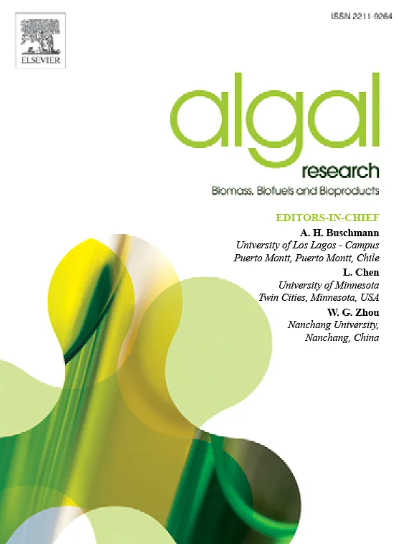Bio-sorption of metformin from aqueous solution using algae-based as effective biosorbents: Process optimization, kinetic, and isotherm studies
IF 4.6
2区 生物学
Q1 BIOTECHNOLOGY & APPLIED MICROBIOLOGY
Algal Research-Biomass Biofuels and Bioproducts
Pub Date : 2025-03-09
DOI:10.1016/j.algal.2025.103996
引用次数: 0
Abstract
The use of algae-based biosorbents to remove pollutants is one of the effective methods for the purification of contaminated water which has received great attention. Here, we used a blue-green algae Spirulina platensis (SP) in three different forms pure SP, KCl-modified SP, and H3PO4-modified SP as biosorbents for the removal of metformin from aqueous environments. The removal experiments of metformin using prepared biosorbents were monitored by various parameters such as pH of the media, contact time, sorbent dosage, and initial concentration of metformin. Adsorption kinetics and isotherms of metformin molecules onto all three biosorbents followed the pseudo-second-order and Langmuir models. Based on the Langmuir model, the maximum adsorption capacity of metformin onto SP, SP/KCl, and SP/H3PO4 was determined as 43.12, 44.64, and 48.54 mg/g, respectively. Green and environmentally friendly nature, cost-effective, easy preparation, good adsorption capacity, high fidelity, and recyclability are some of the prominent characteristics of the introduced biosorbents, which can act as a universal device for water and sewage treatment. A notable benefit of the bio compound of SP/H3PO4 is its optimal use as phosphorus fertilizer before the adsorption of metformin or after the desorption of adsorbed metformin.

求助全文
约1分钟内获得全文
求助全文
来源期刊

Algal Research-Biomass Biofuels and Bioproducts
BIOTECHNOLOGY & APPLIED MICROBIOLOGY-
CiteScore
9.40
自引率
7.80%
发文量
332
期刊介绍:
Algal Research is an international phycology journal covering all areas of emerging technologies in algae biology, biomass production, cultivation, harvesting, extraction, bioproducts, biorefinery, engineering, and econometrics. Algae is defined to include cyanobacteria, microalgae, and protists and symbionts of interest in biotechnology. The journal publishes original research and reviews for the following scope: algal biology, including but not exclusive to: phylogeny, biodiversity, molecular traits, metabolic regulation, and genetic engineering, algal cultivation, e.g. phototrophic systems, heterotrophic systems, and mixotrophic systems, algal harvesting and extraction systems, biotechnology to convert algal biomass and components into biofuels and bioproducts, e.g., nutraceuticals, pharmaceuticals, animal feed, plastics, etc. algal products and their economic assessment
 求助内容:
求助内容: 应助结果提醒方式:
应助结果提醒方式:


